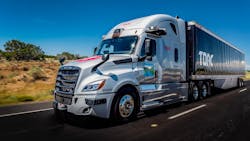It’s all about perception. Developers of the futuristic robotic trucks that could soon supplement freight transport around the U.S. are still fine-tuning how the vehicles perceive the world—traffic, pedestrians, and other unpredictable objects. Doing that takes a lot of expertise.
Autonomous trucking is “hitting some pivotal moments,” according to Mike Avitabile, Torc Robotic’s VP of engineering. It’s not just that the companies developing self-driving tractor-trailers are getting closer to their plans to scale up their products to move freight around the U.S. without humans on board. The industry also is consolidating, the Torc engineer told FleetOwner.
Torc is acquiring Algolux, which in 2021 was named one of the world’s most innovative artificial intelligence startups. An independent subsidiary of Daimler Truck, Torc is the oldest self-driving technology company in the U.S. Founded in 2005, Daimler acquired a majority stake in the AV company in 2019.
See also: More autonomous truck coverage from FleetOwnerThat Daimler support has helped Torc grow aggressively in the competitive AV market—including turning technology partners into colleagues. “We’ve been working with Algolux for over a year,” Avitabile said. “Algolux is a company that really is focused on some advanced vision and machine learning techniques.”
Perception is one of the biggest challenges for AV engineers designing equipment that can control an 80,000-lb. tractor-trailer operating among cars and trucks operated by humans.
“Think about you and I driving down the road in some inclement weather in some variable lighting,” Avitabile explained. “The perception can be quite challenging. Algolux helps us in growing our perception talent—but also bringing some [intellectual property, or IP] to the table to help solve some of those challenging cases around perception—as well as some industry-leading machine learning IP that will help us along this product path.”
Algolux President and CEO Allan Benchetrit said the deal made sense because the two companies share the same “commitment to create robust technology to realize the potential of autonomy and help save lives.”
Seeing safer roads because of AVs
Nearly 43,000 people were killed in motor vehicle crashes in 2022, according to the National Highway Traffic Safety Administration—a slight decrease (0.3%) in highway deaths reported in 2021.
The stagnate statistics show that “the safety crisis on our roadways persists,” according to Jeff Farrah, executive director of the Autonomous Vehicle Industry Association. “Almost 43,000 Americans died, and risky human driving behaviors like speeding, distracted and alcohol-impaired driving all continue to surge. This still represents more than 115 lives lost each day in motor vehicle crashes.”
Farrah said AVs could help solve that crisis: “Unlike human drivers, AVs don’t recklessly speed, drive distracted or inebriated. Changing the unsafe status quo on U.S. roads requires action. Now is the time for Congress and [the U.S. Department of Transportation] to advance policies to support the safe and swift deployment of AVs to help meaningfully make roads in America safer.”
Like other AV trucking companies, Torc focuses on test runs with human safety operators onboard self-driving tractors running freight within the U.S. Sun Belt. The Algolux deal, however, moves Torc closer to truly humanless freight transportation.
Focus on how AVs integrate with fleets
Torc and Algolux are working on multiple perception concepts and methods to improve object detection and distance estimation. Robust perception technology is critical to helping Torc’s autonomous system correctly identify objects in complex visual conditions such as low light, fog, or inclement weather, Avitabile said. Algolux software is operating on initial Freightliner Cascadia test vehicles and is being included in areas of Torc’s software development efforts.
Torc’s direct line to OEM Daimler and its Freightliner trucks was appealing to Montreal-based Algolux.
“This acquisition brings together Algolux’s end-to-end AI stack, from photons to behavior, with Torc’s pioneering autonomous technology. Add in a tightly integrated OEM truck platform and you have a dream scenario,” said Felix Heide, the Algolux chief technology officer. “While many think of autonomous transportation as futuristic, this winning combination will help bring to market a commercially viable, safety-critical long-haul trucking application at scale.”
Once the Torc product is commercially available, Avitabile said fleets would find operational efficiencies and savings. “As far as the fleet customers themselves—large or small—we are focused on how to provide efficient integration with the fleets.”
Along with a team of engineers working on the AV technology, Avitabile said Torc also has a team integrating AV trucks into fleet ecosystems. “We actually call it the logistics integration piece,” he explained.
It’s not just about creating and turning the technology over to fleets. “It’s about the entire system,” Avitabile said. “We talk about the front-end and the logistics integration. We talk about the autonomy. But then there’s also the maintenance and support as well. That’s part of the customer interaction. So that’s part of the efficiencies that we need to make sure we’re keeping in mind. This is something where not only the input from customers but also the support from a name like Daimler and Freightliner brands can help bring to this partnership and instills confidence in fleets.”
When can fleets expect this AV commercialization?
“Torc’s always taken the approach of ‘We’ll release the technology when it’s safe to do so,’” Avitabile said. “Our partnerships continue to provide valuable insight into how we need to develop this product. We believe our focus on customers with the strong back and support of Daimler that we are on a path to being an industry leader in this technology.”
About the Author
Josh Fisher
Editor-in-Chief
Editor-in-Chief Josh Fisher has been with FleetOwner since 2017. He covers everything from modern fleet management to operational efficiency, artificial intelligence, autonomous trucking, alternative fuels and powertrains, regulations, and emerging transportation technology. Based in Maryland, he writes the Lane Shift Ahead column about the changing North American transportation landscape.


